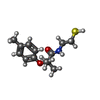+ Open data
Open data
- Basic information
Basic information
| Entry | Database: PDB / ID: 7ba9 | ||||||
|---|---|---|---|---|---|---|---|
| Title | Cys-42-tethered stabilizer 11 of 14-3-3(sigma)/ERa PPI | ||||||
 Components Components |
| ||||||
 Keywords Keywords | SIGNALING PROTEIN / protein-protein interaction / stabilizer / hub protein / transcription factor | ||||||
| Function / homology |  Function and homology information Function and homology informationregulation of epithelial cell apoptotic process / antral ovarian follicle growth / regulation of branching involved in prostate gland morphogenesis / RUNX1 regulates transcription of genes involved in WNT signaling / RUNX1 regulates estrogen receptor mediated transcription / regulation of toll-like receptor signaling pathway / nuclear estrogen receptor activity / epithelial cell development / steroid hormone receptor signaling pathway / epithelial cell proliferation involved in mammary gland duct elongation ...regulation of epithelial cell apoptotic process / antral ovarian follicle growth / regulation of branching involved in prostate gland morphogenesis / RUNX1 regulates transcription of genes involved in WNT signaling / RUNX1 regulates estrogen receptor mediated transcription / regulation of toll-like receptor signaling pathway / nuclear estrogen receptor activity / epithelial cell development / steroid hormone receptor signaling pathway / epithelial cell proliferation involved in mammary gland duct elongation / prostate epithelial cord elongation / regulation of epidermal cell division / protein kinase C inhibitor activity / prostate epithelial cord arborization involved in prostate glandular acinus morphogenesis / positive regulation of epidermal cell differentiation / keratinocyte development / keratinization / mammary gland branching involved in pregnancy / regulation of cell-cell adhesion / negative regulation of smooth muscle cell apoptotic process / uterus development / vagina development / TFIIB-class transcription factor binding / androgen metabolic process / cAMP/PKA signal transduction / Regulation of localization of FOXO transcription factors / keratinocyte proliferation / phosphoserine residue binding / mammary gland alveolus development / cellular response to estrogen stimulus / estrogen response element binding / Activation of BAD and translocation to mitochondria / negative regulation of keratinocyte proliferation / Mitochondrial unfolded protein response (UPRmt) / establishment of skin barrier / nuclear receptor-mediated steroid hormone signaling pathway / negative regulation of protein localization to plasma membrane / positive regulation of DNA-binding transcription factor activity / negative regulation of DNA-binding transcription factor activity / Chk1/Chk2(Cds1) mediated inactivation of Cyclin B:Cdk1 complex / SARS-CoV-2 targets host intracellular signalling and regulatory pathways / Nuclear signaling by ERBB4 / negative regulation of protein kinase activity / negative regulation of stem cell proliferation / RNA polymerase II preinitiation complex assembly / SARS-CoV-1 targets host intracellular signalling and regulatory pathways / RHO GTPases activate PKNs / positive regulation of nitric-oxide synthase activity / estrogen receptor signaling pathway / positive regulation of protein localization / protein localization to chromatin / steroid binding / 14-3-3 protein binding / negative regulation of canonical NF-kappaB signal transduction / TFAP2 (AP-2) family regulates transcription of growth factors and their receptors / positive regulation of cell adhesion / negative regulation of miRNA transcription / protein sequestering activity / negative regulation of innate immune response / protein export from nucleus / ESR-mediated signaling / TBP-class protein binding / TP53 Regulates Transcription of Genes Involved in G2 Cell Cycle Arrest / release of cytochrome c from mitochondria / nitric-oxide synthase regulator activity / positive regulation of protein export from nucleus / nuclear estrogen receptor binding / transcription coregulator binding / transcription corepressor binding / stem cell proliferation / Translocation of SLC2A4 (GLUT4) to the plasma membrane / TP53 Regulates Metabolic Genes / stem cell differentiation / SUMOylation of intracellular receptors / cellular response to estradiol stimulus / euchromatin / beta-catenin binding / Nuclear Receptor transcription pathway / response to estrogen / Regulation of RUNX2 expression and activity / transcription coactivator binding / male gonad development / nuclear receptor activity / Ovarian tumor domain proteases / positive regulation of fibroblast proliferation / intrinsic apoptotic signaling pathway in response to DNA damage / Constitutive Signaling by Aberrant PI3K in Cancer / positive regulation of nitric oxide biosynthetic process / sequence-specific double-stranded DNA binding / intracellular protein localization / response to estradiol / PIP3 activates AKT signaling / regulation of protein localization / positive regulation of cytosolic calcium ion concentration / ATPase binding / PI5P, PP2A and IER3 Regulate PI3K/AKT Signaling / positive regulation of cell growth / regulation of inflammatory response / DNA-binding transcription activator activity, RNA polymerase II-specific / fibroblast proliferation Similarity search - Function | ||||||
| Biological species |  Homo sapiens (human) Homo sapiens (human) | ||||||
| Method |  X-RAY DIFFRACTION / X-RAY DIFFRACTION /  SYNCHROTRON / SYNCHROTRON /  MOLECULAR REPLACEMENT / Resolution: 1.48 Å MOLECULAR REPLACEMENT / Resolution: 1.48 Å | ||||||
 Authors Authors | Sijbesma, E. / Ottmann, C. | ||||||
| Funding support |  Netherlands, 1items Netherlands, 1items
| ||||||
 Citation Citation |  Journal: Acs Med.Chem.Lett. / Year: 2021 Journal: Acs Med.Chem.Lett. / Year: 2021Title: Exploration of a 14-3-3 PPI Pocket by Covalent Fragments as Stabilizers. Authors: Sijbesma, E. / Hallenbeck, K.K. / Andrei, S.A. / Rust, R.R. / Adriaans, J.M.C. / Brunsveld, L. / Arkin, M.R. / Ottmann, C. | ||||||
| History |
|
- Structure visualization
Structure visualization
| Structure viewer | Molecule:  Molmil Molmil Jmol/JSmol Jmol/JSmol |
|---|
- Downloads & links
Downloads & links
- Download
Download
| PDBx/mmCIF format |  7ba9.cif.gz 7ba9.cif.gz | 71.9 KB | Display |  PDBx/mmCIF format PDBx/mmCIF format |
|---|---|---|---|---|
| PDB format |  pdb7ba9.ent.gz pdb7ba9.ent.gz | 50.7 KB | Display |  PDB format PDB format |
| PDBx/mmJSON format |  7ba9.json.gz 7ba9.json.gz | Tree view |  PDBx/mmJSON format PDBx/mmJSON format | |
| Others |  Other downloads Other downloads |
-Validation report
| Summary document |  7ba9_validation.pdf.gz 7ba9_validation.pdf.gz | 565.2 KB | Display |  wwPDB validaton report wwPDB validaton report |
|---|---|---|---|---|
| Full document |  7ba9_full_validation.pdf.gz 7ba9_full_validation.pdf.gz | 565.2 KB | Display | |
| Data in XML |  7ba9_validation.xml.gz 7ba9_validation.xml.gz | 14.1 KB | Display | |
| Data in CIF |  7ba9_validation.cif.gz 7ba9_validation.cif.gz | 21.6 KB | Display | |
| Arichive directory |  https://data.pdbj.org/pub/pdb/validation_reports/ba/7ba9 https://data.pdbj.org/pub/pdb/validation_reports/ba/7ba9 ftp://data.pdbj.org/pub/pdb/validation_reports/ba/7ba9 ftp://data.pdbj.org/pub/pdb/validation_reports/ba/7ba9 | HTTPS FTP |
-Related structure data
| Related structure data |  7b9mC  7b9rC  7b9tC  7ba3C 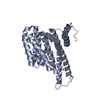 7ba5C  7ba6C  7ba7C  7ba8C  7baaC  7babC 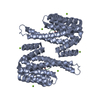 4jc3S S: Starting model for refinement C: citing same article ( |
|---|---|
| Similar structure data |
- Links
Links
- Assembly
Assembly
| Deposited unit | 
| ||||||||
|---|---|---|---|---|---|---|---|---|---|
| 1 | 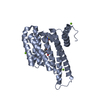
| ||||||||
| Unit cell |
|
- Components
Components
| #1: Protein | Mass: 26542.914 Da / Num. of mol.: 1 Source method: isolated from a genetically manipulated source Source: (gene. exp.)  Homo sapiens (human) / Gene: SFN, HME1 / Production host: Homo sapiens (human) / Gene: SFN, HME1 / Production host:  | ||||||||
|---|---|---|---|---|---|---|---|---|---|
| #2: Protein/peptide | Mass: 870.840 Da / Num. of mol.: 1 / Source method: obtained synthetically / Source: (synth.)  Homo sapiens (human) / References: UniProt: P03372 Homo sapiens (human) / References: UniProt: P03372 | ||||||||
| #3: Chemical | | #4: Chemical | ChemComp-T6N / | #5: Water | ChemComp-HOH / | Has ligand of interest | Y | Has protein modification | Y | |
-Experimental details
-Experiment
| Experiment | Method:  X-RAY DIFFRACTION / Number of used crystals: 1 X-RAY DIFFRACTION / Number of used crystals: 1 |
|---|
- Sample preparation
Sample preparation
| Crystal | Density Matthews: 2.6 Å3/Da / Density % sol: 52.74 % |
|---|---|
| Crystal grow | Temperature: 277 K / Method: vapor diffusion, sitting drop / pH: 7.1 Details: 0.095 M HEPES, 0.19 M CaCl2, 27% (v/v) PEG400, 5% (v/v) glycerol |
-Data collection
| Diffraction | Mean temperature: 80 K / Serial crystal experiment: N | ||||||||||||||||||||||||||||||
|---|---|---|---|---|---|---|---|---|---|---|---|---|---|---|---|---|---|---|---|---|---|---|---|---|---|---|---|---|---|---|---|
| Diffraction source | Source:  SYNCHROTRON / Site: SYNCHROTRON / Site:  PETRA III, DESY PETRA III, DESY  / Beamline: P11 / Wavelength: 1.033 Å / Beamline: P11 / Wavelength: 1.033 Å | ||||||||||||||||||||||||||||||
| Detector | Type: DECTRIS PILATUS 6M / Detector: PIXEL / Date: May 5, 2017 | ||||||||||||||||||||||||||||||
| Radiation | Protocol: SINGLE WAVELENGTH / Monochromatic (M) / Laue (L): M / Scattering type: x-ray | ||||||||||||||||||||||||||||||
| Radiation wavelength | Wavelength: 1.033 Å / Relative weight: 1 | ||||||||||||||||||||||||||||||
| Reflection | Resolution: 1.48→66.04 Å / Num. obs: 47850 / % possible obs: 99.8 % / Redundancy: 13.1 % / CC1/2: 1 / Rmerge(I) obs: 0.091 / Rpim(I) all: 0.026 / Rrim(I) all: 0.094 / Net I/σ(I): 17.8 / Num. measured all: 624764 / Scaling rejects: 3 | ||||||||||||||||||||||||||||||
| Reflection shell | Diffraction-ID: 1
|
- Processing
Processing
| Software |
| ||||||||||||||||||||||||||||||||||||||||||||||||||||||||||||||||||||||||||||||||||||||||||||||||||||||||||||
|---|---|---|---|---|---|---|---|---|---|---|---|---|---|---|---|---|---|---|---|---|---|---|---|---|---|---|---|---|---|---|---|---|---|---|---|---|---|---|---|---|---|---|---|---|---|---|---|---|---|---|---|---|---|---|---|---|---|---|---|---|---|---|---|---|---|---|---|---|---|---|---|---|---|---|---|---|---|---|---|---|---|---|---|---|---|---|---|---|---|---|---|---|---|---|---|---|---|---|---|---|---|---|---|---|---|---|---|---|---|
| Refinement | Method to determine structure:  MOLECULAR REPLACEMENT MOLECULAR REPLACEMENTStarting model: 4JC3 Resolution: 1.48→45.317 Å / SU ML: 0.15 / Cross valid method: THROUGHOUT / σ(F): 1.34 / Phase error: 20.67 / Stereochemistry target values: ML
| ||||||||||||||||||||||||||||||||||||||||||||||||||||||||||||||||||||||||||||||||||||||||||||||||||||||||||||
| Solvent computation | Shrinkage radii: 0.9 Å / VDW probe radii: 1.11 Å / Solvent model: FLAT BULK SOLVENT MODEL | ||||||||||||||||||||||||||||||||||||||||||||||||||||||||||||||||||||||||||||||||||||||||||||||||||||||||||||
| Displacement parameters | Biso max: 87.81 Å2 / Biso mean: 22.6345 Å2 / Biso min: 10.61 Å2 | ||||||||||||||||||||||||||||||||||||||||||||||||||||||||||||||||||||||||||||||||||||||||||||||||||||||||||||
| Refinement step | Cycle: final / Resolution: 1.48→45.317 Å
| ||||||||||||||||||||||||||||||||||||||||||||||||||||||||||||||||||||||||||||||||||||||||||||||||||||||||||||
| LS refinement shell | Refine-ID: X-RAY DIFFRACTION / Rfactor Rfree error: 0
|
 Movie
Movie Controller
Controller







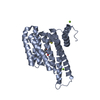
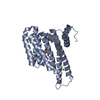
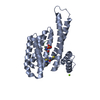

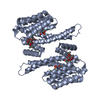



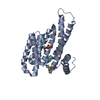
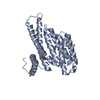
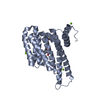
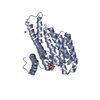
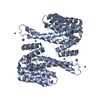
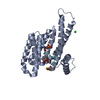
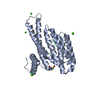
 PDBj
PDBj

















